
The Parmeliaceae is a large and diverse family of Lecanoromycetes. With over 2700 species in 71 genera, it is the largest family of lichen-forming fungi. The most speciose genera in the family are the well-known groups: Xanthoparmelia, Usnea, Parmotrema, and Hypotrachyna.

Pseudevernia is a genus of foliose lichens in the family Parmeliaceae. The type species of the genus, Pseudevernia furfuracea, has substantial commercial value in the perfume industry.

Vulpicida is a genus of lichenized fungi in the family Parmeliaceae. Circumscribed in 1993 to contain species formerly placed in Cetraria, the genus is widespread in Arctic to northern temperate regions, and contains six species. The genus is characterized by the presence of the secondary metabolites pulvinic acid and vulpinic acid, compounds that when combined with usnic acid, give the species their characteristic yellow and green colors.
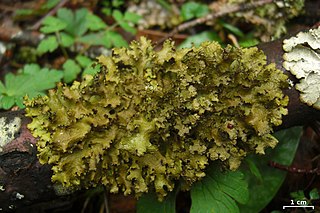
Tuckermannopsis is a genus of foliose lichens in the family Parmeliaceae.

Cetrelia is a genus of leafy lichens in the large family Parmeliaceae. They are commonly known as sea-storm lichens, alluding to the wavy appearance of their lobes. The name of the genus, circumscribed in 1968 by the husband and wife lichenologists William and Chicita Culberson, alludes to the former placement of these species in the genera Cetraria and Parmelia.
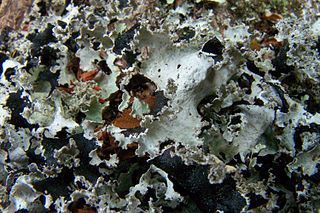
Platismatia is genus of medium to large foliose lichens in the family Parmeliaceae. The genus is widespread and contains 11 species. They resemble many other genera of foliose lichens in the Parmeliaceae, particularly Parmotrema, Cetrelia, and Asahinea. Most species are found in forests on the trunks and branches of conifer trees, although some species grow on rocks.
Vermilacinia cerebra is a fruticose lichen that grows on trees and shrubs in the fog regions along the Pacific Coast of North America from the Channel Islands and mainland California near Los Angeles to southern Baja California, also occurring in South America in the Antofagasta Province of northern Chile. The epithet is in reference to the apical swollen lobes that resemble the cerebrum of the brain.
Hypogymnia congesta is a rare species of foliose lichen in the family Parmeliaceae. Found in China, it was formally described as a new species in 2003. The lichen grows on the bark and wood of conifers and bamboo. Hypogymnia congesta has a brown to brownish-grey foliose thallus measuring up to 8 cm (3.1 in) long or broad, with a cartilage-like texture. The lichen is chemically distinct, containing physodic acid and virensic acid; the latter substance is otherwise unknown from genus Hypogymnia.

Parmelia omphalodes is a species of foliose lichen in the family Parmeliaceae. It is one of the several dozen lichen species first described in 1753 by Carl Linnaeus. Swedish lichenologist Erik Acharius transferred it to the genus Parmelia in 1803. The lichen is widely distributed, having been recorded in Asia, Africa, Europe, and North and South Americas. Morphologically similar–but genetically distinct–species include Parmelia discordans and P. pinnatifida.

Cetrelia chicitae is a species of foliose lichen in the family Parmeliaceae. It is found in eastern Asia, North America, and Europe, where it grows on mossy rocks and tree trunks.
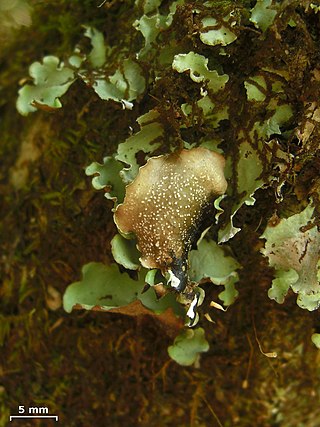
Cetrelia monachorum is a species of foliose lichen in the family Parmeliaceae. It was first described scientifically in 1930 by Alexander Zahlbruckner as a species of Parmelia. Husband and wife lichenologists William and Chicita Culberson transferred it into the genus Cetrelia in 1977. It is found in Asia, Europe, and North America.
Lichen products, also known as lichen substances, are organic compounds produced by a lichen. Specifically, they are secondary metabolites. Lichen products are represented in several different chemical classes, including terpenoids, orcinol derivatives, chromones, xanthones, depsides, and depsidones. Over 800 lichen products of known chemical structure have been reported in the scientific literature, and most of these compounds are exclusively found in lichens. Examples of lichen products include usnic acid, atranorin, lichexanthone, salazinic acid, and isolichenan, an α-glucan. Many lichen products have biological activity, and research into these effects is ongoing.
Platismatia formosana is a species of corticolous (bark-dwelling), foliose lichen in the family Parmeliaceae. Found in the mountains of Taiwan, it was first formally described as a species of Cetraria in 1933 by Alexander Zahlbruckner. William and Chicita Culberson transferred it to the genus Platismatia in 1968. The species epithet formosana refers to its distribution, as "Formosa" is name formerly used in Western literature to refer to Taiwan. It contains the lichen products atranorin, caperatic acid, and an unidentified yellow pigment.
Platismatia erosa is a species of corticolous (bark-dwelling), foliose lichen in the family Parmeliaceae. Found in Asia, it was formally described as a new species in 1968 by William and Chicita Culberson. The species epithet erosa refers to the "eroded" quality of the reticulations on the upper thallus surface. The lichen has been recorded from Japan, Taiwan, Java, Vietnam, Nepal, the Philippines, and Sikkim, and Tibet. Chemical analysis of the lichen revealed two lichen products previously unknown in genus Platismatia, pannaric acid and jackinic acid. Two chemotypes of P. erosa have been identified, containing different proportions of these substances.
Platismatia lacunosa is a species of corticolous (bark-dwelling), foliose lichen in the family Parmeliaceae. Known predominantly from western North America, it was first formally described in 1803 by Erik Acharius. William and Chicita Culberson transferred it to the genus Platismatia in 1968. P. lacunosa was recorded from the Commander Islands in the Russian Far East in 2021.
Platismatia interrupta is a species of foliose lichen in the family Parmeliaceae. Found in southern Russian Far East, and Japan, it was formally described as a new species in 1968 by William and Chicita Culberson. The species epithet interrupta refers to the indistinct and discontinuous reticulation of the upper thallus surface. The lichen of one of the most common foliose macrolichens in Japan, particularly at high elevations, where it grows on tree trunks and on boulders. The authors called it the "Far Eastern equivalent" of the common and widespread Platismatia glauca, which is absent in Asia.
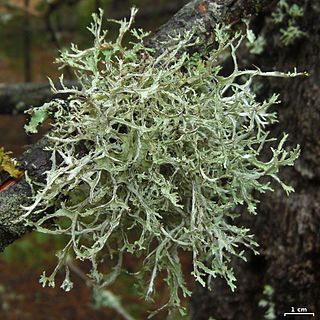
Platismatia stenophylla is a species of corticolous (bark-dwelling), foliose lichen in the family Parmeliaceae. It is found in western North America, from Vancouver Island south to central California, usually close to a shore. It was first formally described as a species of Cetrelia in 1882 by American lichenologist Edward Tuckerman. William and Chicita Culberson transferred it to the genus Platismatia in 1968. The lichen is distinguished from others in its genus by its narrow, linear lobes. It contains caperatic acid and atranorin as lichen products.
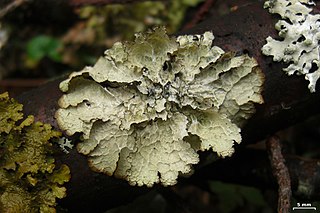
Platismatia tuckermanii is a species of corticolous (bark-dwelling), foliose lichen in the family Parmeliaceae. It was first formally described as a species of Cetraria in 1843 by American botanist William Oakes. The species epithet honours lichenologist Edward Tuckerman, who collected the type specimen in Cambridge, Massachusetts, in 1838. William and Chicita Culberson transferred the taxon to the genus Platismatia in 1968. The lichen is found in Canada and the Southeastern United States. Although usually encountered growing on conifer bark, it is also known to grow on old wooden fenceposts. It contains caperatic acid and atranorin as lichen products.
Platismatia regenerans is a species of corticolous (bark-dwelling), foliose lichen in the family Parmeliaceae. Found in Borneo, it was formally described as a new species in 1968 by William and Chicita Culberson. The type specimen was collected by Mason Hale from the Kinabalu National Park in Sabah, at an elevation of 2,000 m (6,600 ft). The species epithet refers to the "regenerative lobulae" that occur on older parts of the thallus.

Platismatia herrei is a species of corticolous (bark-dwelling), foliose lichen in the family Parmeliaceae. It was first formally described as a species of Cetraria in 1968 by lichenologist Henry Imshaug. William and Chicita Culberson transferred it to the genus Platismatia in 1968. The lichen is found in western North America, ranging from southern Alaska to central California. It is distinguished from other members of its genus by the isidia that fringe the edges of its linear lobes; the Culbersons described it as "one of the most beautiful and intricately formed species in the genus".












